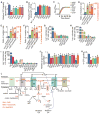Identity and function of a large gene network underlying mutagenic repair of DNA breaks
- PMID: 23224554
- PMCID: PMC3782309
- DOI: 10.1126/science.1226683
Identity and function of a large gene network underlying mutagenic repair of DNA breaks
Abstract
Mechanisms of DNA repair and mutagenesis are defined on the basis of relatively few proteins acting on DNA, yet the identities and functions of all proteins required are unknown. Here, we identify the network that underlies mutagenic repair of DNA breaks in stressed Escherichia coli and define functions for much of it. Using a comprehensive screen, we identified a network of ≥93 genes that function in mutation. Most operate upstream of activation of three required stress responses (RpoS, RpoE, and SOS, key network hubs), apparently sensing stress. The results reveal how a network integrates mutagenic repair into the biology of the cell, show specific pathways of environmental sensing, demonstrate the centrality of stress responses, and imply that these responses are attractive as potential drug targets for blocking the evolution of pathogens.
Figures




References
Publication types
MeSH terms
Substances
Grants and funding
- R01 GM064022/GM/NIGMS NIH HHS/United States
- DP1-CA174424/CA/NCI NIH HHS/United States
- F32-GM19909/GM/NIGMS NIH HHS/United States
- GM79656/GM/NIGMS NIH HHS/United States
- R01 GM066099/GM/NIGMS NIH HHS/United States
- R01-GM64022/GM/NIGMS NIH HHS/United States
- F32-GM095267/GM/NIGMS NIH HHS/United States
- F32 GM095267/GM/NIGMS NIH HHS/United States
- R25 GM056929/GM/NIGMS NIH HHS/United States
- R01 GM053158/GM/NIGMS NIH HHS/United States
- R01-GM53158/GM/NIGMS NIH HHS/United States
- DP1 CA174424/CA/NCI NIH HHS/United States
- GM66099/GM/NIGMS NIH HHS/United States
- R01 GM079656/GM/NIGMS NIH HHS/United States
- F32 GM019909/GM/NIGMS NIH HHS/United States
LinkOut - more resources
Full Text Sources
Other Literature Sources
Molecular Biology Databases

